1
Section One: The Fundamentals
A) What do we know about sport? What are common assumptions we make about sport and society?

| Sport offers various opportunities for people to develop their character. Teamwork, collaboration, leadership, resilience, and other skills can all help to shape character. Looking at leadership, for example, this can allow someone involved in sports to take on a role that they may or may not be familiar with, but this new job can benefit them in a variety of ways. It can help them gain confidence, responsibility, and the desire to motivate others to succeed. However, sports do not necessarily develop character in some people and athletes. For example, poor coaching or adult support could be to blame. As an athlete who has competed in sports my whole life, I have had both positive and negative experiences with coaches. Recently, I had a horrible encounter with a coach, which affected my perception of myself, my sport, and my motivation to do what I love. Poor coaches can have a significant impact on a person’s character development. Most of the time in sports, the athlete performs with a coach, listens to their advice, and follows their instructions. However, if a coach acts negatively, such as putting their players down or treating them unfairly in comparison to others, this has the potential to diminish the athlete’s character. |
Exercise 3: Notebook prompt
What are some other metanarratives about sport that you are familiar with? Find an image or video clip or draw something yourself that captures this idea…
So what? Why does any of this matter? Does it matter? As something we grow up with – live with – play through – we don’t often interrogate the meanings of sport, and perhaps we don’t want to.
But being aware of these assumptions and metanarratives is especially important, I would argue, because of the centrality of sport to our everyday lives, the role that sport plays in shaping our childhood and worldviews and….. [finish that thought]
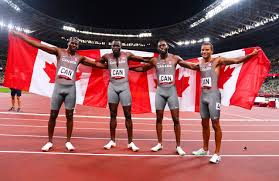
A metanarrative about sports that I am familiar with is the idea that athletes are “invincible”. The public typically views athletes as superhumans who do not face struggles and issues like any other person in our world. Since they are famous, and possibly doing well in their sport they are often expected to have little to no issues. However, when an athlete does speak out about things like mental health issues, it seems to be the biggest deal to the public especially on social media. In addition to this, athletes are also expected to perform at their best when they are expected to. Looking at the Olympics for example, some athletes are given one or more chances to win their event and are expected to show up and be perfect on that day. Especially if they may be considered the best compared to others, they are expected to beat everyone else again and again. However, what if it is simply not their day? This is a metanarrative that the world needs to understand. Another metanarrative that I have heard is the underdog win. This narrative occurs when a player or team wins something like a game or event when they odds were greatly against them. A lot of the public fame is not only pointed towards the underdog’s winning but also the athlete or team expected to win, losing. Looking back at the 2024 Olympics as an example, Canada won the men’s 4x 100 meter relay and the biggest upset was USA losing. But being aware of these assumptions and metanarratives are especially important, I would argue, because of the centrality of sport to our everyday lives, the role that sport plays in shaping our childhood and worldviews and…... [finish that thought] the way that it influences our beliefs and understandings of ourselves and others.
|
B) What is social justice?
Exercise 4: Padlet Prompt
Think back to the last section and try to look at some of the ideas we discussed differently. How might sport and social justice actually co-exist?
Record any images, video clips, or gifs you added to the padlet and identify a point of intersection between sport and social justice (can be an issue or a barrier or a debate or something you would like to explore in more depth in this course) . Screenshot or paste in your response below.
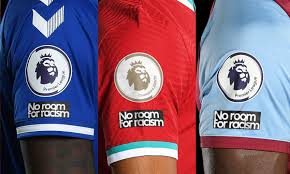
The Premier League’s No Room For Racism action plan demonstrates its commitment to combating discrimination. The players’ shirts say “No Room For Racism” on the sleeves. This action is not just to promote equality for football players, but also to encourage everyone involved, including fans, coaches, players, police, supporters, and others, to stand against discrimination and promote diversity, inclusion, and equality both on and off the field. This highlights the link between social justice and sports. Looking at the photo above, it is clear that social justice issues persist in the globe, and platforms must use their voices to help make change. The Premier League’s decision to initiate this action is more than just words on a shirt; it reflects the ongoing difficulties in sport and the widespread need to take action. |
C) Social Justice Reading
(note: this activity is optional!)
D) KINESIOLOGY AND SOCIAL JUSTICE
Exercise 5:




Exercise 6:
What are the implications of bodies-at-risk discourse and the refusal to understand the health gap from a social justice perspective, according to the authors of this article?
|
In the article, Harrison highlights the different marginalized groups such as ethnic minority groups, women, people in poverty, and people with disabilities who are typically framed through the bodies-at-risk discourse (2021). This discourse sheds emphasis on these marginalized groups and how they are vulnerable to poor health outcomes. However, this issue is not considered based on broader systemic concerns like discrimination, health inequalities, or poverty. As Harrison stated, the blame is placed on marginalized groups and their own choices to remain physically active and healthy (2021). The implication of bodies-at-risk discourse is the inability to recognize the broader issues impacting these marginalized groups’ health. This demonstrates the systemic barriers that are preventing these groups from receiving opportunities like equal access to healthcare. Harrison also examines the failure to view the health gap from a social justice perspective, which ultimately ignores the different factors contributing to health inequalities (2021). For example, in order to understand health inequalities between populations, all elements must be considered, including social and political factors, discrimination, and so on. This will allow health disparities to be investigated from a social justice perspective that is inclusive and targets the root cause of disparity, rather than focusing solely on individual behaviors. As Harrison stated, this viewpoint can encourage more equitable policies and interventions that emphasize the health of all groups and communities, especially those that are frequently disadvantaged. |
Section Two: Sport Feminism
Exercise 7: Notebook Prompt
What is feminism? What does it mean to you? Choose one of the images below and explain how it captures your understanding of feminism (or find one that does speak to you and paste this into your pressbook with an explanation of why it matters to you.
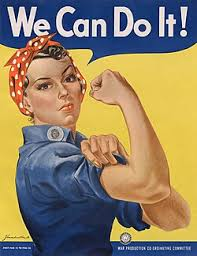
Feminism is gender equality. It is about women receiving equal rights, freedom, equal opportunities and so much more. To me, feminism is about advocating for women to have equal opportunities and challenging society’s ways of thinking about women and gender stereotypes. For example, challenging stereotypes about women in relation to work, family, or at home responsibilities like equal job opportunities and eliminating workplace violation of any sort. An important part of feminism to me is women having reproductive rights. As a woman myself, my body is my body and I should have the right to make decisions for myself about my body. Looking at abortions, for example, this decision is illegal in some countries meaning that women have no say when it comes to making this decision. The image above captures my understanding of feminism. Focusing on gender stereotypes, men are typically viewed as more strong and powerful than women. I am someone who works out a lot and I have been told that I don’t need big muscles because that physique is only for men. This image however of a woman flexing her arm and saying “We can do it” is amazing to me. It shows that women are such strong and powerful human beings and deserve so much in this world. We as women deserve equal rights, and freedom and should be allowed to look however we want. |
Exercise 8: Notes Prompt (optional)
NB: Cornell notes is a great resource that teaches effective notetaking. Unfortunately, our system can’t save notes taken in the H5P app, so this is fully optional.
Exercise 9: Crossword Activity
. 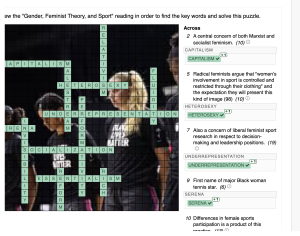
Exercise 10: Padlet Prompt
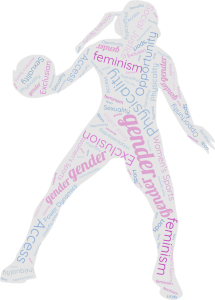 |

|
|


Feedback/Errata